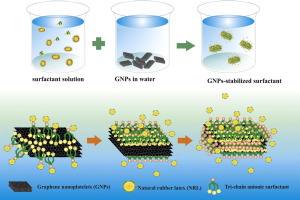Journal of Colloid and Interface Science ( IF 9.4 ) Pub Date : 2018-01-11 , DOI: 10.1016/j.jcis.2018.01.041 Azmi Mohamed , Tretya Ardyani , Suriani Abu Bakar , Masanobu Sagisaka , Yasushi Umetsu , J.J. Hamon , Bazura Abdul Rahim , Siti Rahmah Esa , H.P.S. Abdul Khalil , Mohamad Hafiz Mamat , Stephen King , Julian Eastoe

|
Hypothesis
Graphene nanoplatelets (GNPs) can be dispersed in natural rubber matrices using surfactants. The stability and properties of these composites can be optimized by the choice of surfactants employed as stabilizers. Surfactants can be designed and synthesized to have enhanced compatibility with GNPs as compared to commercially available common surfactants. Including aromatic groups in the hydrophobic chain termini improves graphene compatibility of surfactants, which is expected to increase with the number of aromatic moieties per surfactant molecule. Hence, it is of interest to study the relationship between molecular structure, dispersion stability and electrical conductivity enhancement for single-, double-, and triple-chain anionic graphene-compatible surfactants.
Experiments
Graphene-philic surfactants, bearing two and three chains phenylated at their chain termini, were synthesized and characterized by proton nuclear magnetic resonance (1H NMR) spectroscopy. These were used to formulate and stabilize dispersion of GNPs in natural rubber latex matrices, and the properties of systems comprising the new phenyl-surfactants were compared with commercially available surfactants, sodium dodecylsulfate (SDS) and sodium dodecylbenzenesulfonate (SDBS). Raman spectroscopy, field emission scanning electron microscopy (FESEM), atomic force microscopy (AFM), and high-resolution transmission electron microscopy (HRTEM) were used to study structural properties of the materials. Electrical conductivity measurements and Zeta potential measurements were used to assess the relationships between surfactant architecture and nanocomposite properties. Small-angle neutron scattering (SANS) was used to study self-assembly structure of surfactants.
Findings
Of these different surfactants, the tri-chain aromatic surfactant TC3Ph3 (sodium 1,5-dioxo-1,5-bis(3-phenylpropoxy)-3-((3phenylpropoxy)carbonyl) pentane-2-sulfonate) was shown to be highly graphene-compatible (nanocomposite electrical conductivity = 2.22 × 10−5 S cm−1), demonstrating enhanced electrical conductivity over nine orders of magnitude higher than neat natural rubber-latex matrix (1.51 × 10−14 S cm−1). Varying the number of aromatic moieties in the surfactants appears to cause significant differences to the final properties of the nanocomposites.
中文翻译:

石墨烯/天然橡胶胶乳纳米复合材料芳烃表面活性剂的合理设计
假设
可以使用表面活性剂将石墨烯纳米片(GNP)分散在天然橡胶基质中。这些复合材料的稳定性和性能可以通过选择用作稳定剂的表面活性剂来优化。与市售的常用表面活性剂相比,可以设计和合成表面活性剂以增强与GNP的相容性。在疏水链末端包括芳族基团改善了表面活性剂的石墨烯相容性,这预期随着每个表面活性剂分子的芳族部分数目的增加而增加。因此,研究单链,双链和三链阴离子石墨烯相容性表面活性剂的分子结构,分散稳定性和电导率增强之间的关系是有意义的。
实验
合成了亲石墨烯表面活性剂,在其链末端带有两个和三个链被苯基化的链,并通过质子核磁共振表征(11 H NMR)光谱。这些用于配制和稳定GNP在天然橡胶胶乳基质中的分散,并将包含新型苯基表面活性剂的体系的性能与市售表面活性剂十二烷基硫酸钠(SDS)和十二烷基苯磺酸钠(SDBS)进行比较。拉曼光谱,场发射扫描电子显微镜(FESEM),原子力显微镜(AFM)和高分辨率透射电子显微镜(HRTEM)用于研究材料的结构特性。电导率测量和Zeta电位测量用于评估表面活性剂结构与纳米复合材料性能之间的关系。小角度中子散射(SANS)用于研究表面活性剂的自组装结构。
发现
在这些不同的表面活性剂中,三链芳族表面活性剂TC3Ph3(1,5-二氧代-1,5-双(3-苯基丙氧基)-3-((3苯基丙氧基)羰基)戊烷-2-磺酸钠)被显示为高度与石墨烯相容(纳米复合材料电导率= 2.22×10 -5 S cm -1),显示出比纯天然橡胶-乳胶基质(1.51×10 -14 S cm -1)高9个数量级的增强电导率。表面活性剂中芳族部分的数目的变化似乎引起纳米复合材料的最终性能的显着差异。











































 京公网安备 11010802027423号
京公网安备 11010802027423号